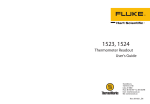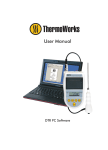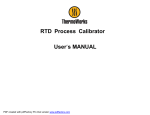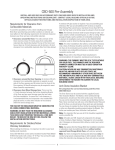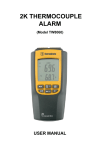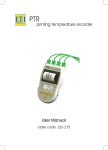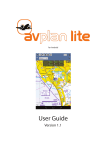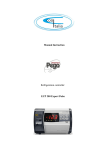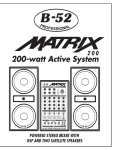Download PTR/DTR - ThermoWorks.com
Transcript
PTR/DTR
Printing Thermometer Software
Software User Manual
CONTENTS
Introduction4
To install the PTR/DTR PC software
4
General tab
6
Device6
Settings6
Status6
Ticket preview
6
Layout7
Selecting a PTR/DTR
7
Getting settings from the device
7
Configuring the PTR/DTR
8
Modifying ticket layout
8
Selecting an image
8
Editing user fields
9
Changing the date/time format
9
Defining the labels & limits - DTR
10
Defining the labels & limits - PTR
11
Changing the temperature units 11
Saving the ticket layout & settings to the PC
12
Loading the ticket layout & settings to the PC
13
Deleting saved ticket layout & settings
13
Data tab
14
Retrieving stored readings from the device
14
Readings14
Download readings from the PTR/DTR
2
15
Erasing readings from the devise
15
Exporting readings to excel file
16
Advanced tab - PTR
17
Auto-off17
Mode options
18
On demand mode
18
Ticket headings - on demand mode
18
Summary mode
18
Ticket headings - summary mode
19
Logging mode
19
Ticket heaings - logging mode
20
Reading trim
20
Advanced tab - DTR
21
Operation of the probe button
21
Changing the delay time for remote button printing
21
Number of copies to be printed using the remote button
22
Auto-off22
Ticket headings - DTR
22
Resetting the advanced settings to default values
23
Notes23
3
INTRODUCTION
The PTR/DTR printing thermometer PC software is used to configure the
thermometer and retrieve stored readings from it.
The PTR has 4 inputs that can be renamed (user selectable). Each input has
an assigned high and low limit (user selectable). The DTR can store up to 4
labels (user selectable). Each label has an assigned high and low limit (user
selectable). When a temperature is taken the label and limits will be printed on
the ticket and stored with the readings.
The following pages explain how to adjust the user selectable information shown
on the PTR/DTR display and the printed ticket and retrieve the stored readings.
Place the CD in the CD drive.
TO INSTALL THE PTR/DTR PC SOFTWARE
The CD will auto-run. (If it does not, click 'Start', 'Run...', browse to the CD drive
and click ‘Setup.exe’
or double click the 'My Computer' icon on the Desktop and double click the CD
drive.
When the 'Printing Temperature Recorder Setup Wizard' box appears click the
next button.
4
The program files will be installed by default to...
''C:\Program Files\ETI Ltd\Printing Temperature Recorder\'' (Recommended).
The 'Browse' button can be used to install to an alternate location (Advanced
Users).
The 'Disk Cost' button will show the space on available drives and the amount
required.
The software may be installed for the current user or all users of the PC.
The default installation is 'Everyone'. Select the alternate button for 'Just me'
(Advanced Users).
The final installation dialogue box gives a last opportunity to go back and revise
the installation settings. Click the 'Next' button to install the software. A moving
bar will show the installation progress.
Click the 'Close' button to exit the installation procedure.
An icon for the Printing Temperature Recorder will be placed on the desktop.
A Printing Temperature Recorder shortcut will be placed in 'Start menu' 'Programs' - 'ETI Ltd'.
5
GENERAL TAB
DEVICE
When working on ticket layouts without a device connected to the PC select DTR
or PTR. When devices are plugged into the PC USB sockets this box will contain
a drop down list of all the available PTR/DTR units.
SETTINGS
GET - retrieves current settings and ticket layout from the PTR/DTR.
SET - configures the PTR/DTR with selected settings and ticket layout.
STATUS
Displays the number of readings stored in PTR/DTR memory and the time the
PTR/DTR was synchronised.
TICKET PREVIEW
Allows the 'Ticket layout' to be modified in 'what you see is what you get (WYSIWYG)' style. Edit mode is entered by hovering the mouse cursor over the fields
within the ticket area. All user-selectable fields and their descriptions appear.
Leaving the ticket area, disables the edit mode and the actual ticket layout is
shown.
6
LAYOUT
SAVE – saves the current ticket layout to the PC.
LOAD – loads saved ticket layout from the PC.
DELETE – deletes a saved ticket layout.
CLOSE – closes the software.
SELECTING A PTR/DTR
If more than one PTR/DTR device is plugged into the PC, use this drop-down list
to select the appropriate one.
When a PTR/DTR is selected, the settings stored in it will be downloaded
automatically.
WARNING: any changes made to the currently displayed ticket layout or
settings will be overwritten.
GETTING SETTINGS FROM THE DEVICE
To retrieve the ticket layout and settings stored on the PTR/DTR device, click the
'Get' button in the 'Settings' section.
Do not disconnect device from the PC until operation complete.
7
CONFIGURING THE PTR/DTR
To configure the PTR/DTR with the current ticket layout and settings, click the
'Set' button in the 'Settings' section.
Do not disconnect device from the PC until operation complete.
MODIFYING THE TICKET LAYOUT
SELECTING AN IMAGE
To select an image to be displayed on the ticket, hover the mouse cursor over
the image area or existing image in the 'Ticket layout' section. The cursor will
change to a hand shape and clicking on the area or image will show the 'Select
image' dialogue box.
Select an image file from the PC and click 'Open'.
The PTR/DTR can only print black and white so the image will be converted
to black and white. If contrast adjustment is needed, use the slide control. To
make the image lighter slide the control to the left. To make the image darker
slide the control to the right.
8
To erase the existing image, click the 'X' button at the top right corner of the
image area.
EDITING USER FIELDS
A DTR ticket has eight user selectable fields on the layout: 'Header', 'User Fields
1-3' and 'Footers 1-4'.
A PTR in 'Log' mode has only the 'Header' field appear.
A PTR in 'Summary' mode has 'Header' and 'Footers 1 – 4'.
A PTR in non-logging mode has eight user selectable fields on the layout: 'Header',
'User Fields 1-3' and 'Footers 1-4'.
Hover the mouse cursor over the corresponding field to highlight and click on
it to modify.
If a field is left empty, it will not be displayed on the 'Ticket layout' when the edit
mode is exited (and therefore, will not be printed).
CHANGING THE DATE/TIME FORMAT
To change the Date/Time format to either UK (dd/mm/yy hh:mm:ss) or US (mm/
dd/yy hh:mm:ss), hover the mouse cursor over the 'Date/Time' field in the 'Ticket
layout' area. The cursor will change to a hand shape and clicking on the area
shows the format pop-up box. Select the required format from the pop-up box.
9
DEFINING THE LABELS AND LIMITS - DTR
The DTR has 1 input and up to four labels can be defined for use. These labels
can each have their own high and low limits.
Each reading taken by the device is assigned the label selected at the time. The
reading’s alarm state is determined by its label’s high and low limits.
To change the name of a label and its limits, click on the Labels field on the ticket
layout area.
Radio buttons on the left determine the selected label on instrument start-up.
The high and low limits are selected from the drop-down boxes. The high limit
must be greater than the low limit and vice-versa.
10
DEFINING THE LABELS AND LIMITS – PTR
The PTR has 4 inputs. To define inputs and their high and low limits simply hover
the mouse cursor over the 'Inputs' field on the 'Ticket layout' area. Clicking on
it will show the 'Inputs' pop-up box. Edit the Input name and select the high and
low limits from the appropriate scroll lists.
CHANGING THE TEMPERATURE UNITS
To change temperature units to either °C or °F, hover the mouse cursor over the
'Inputs' field on the 'Ticket layout' area. The cursor will change to a hand shape
and clicking on it will show the input pop-up box. Select the required measurement
units from the pop-up box.
11
SAVING THE TICKET LAYOUT AND SETTINGS TO THE PC
To save the current 'Ticket layout' to the PC, along with the selected settings,
click the 'Save' button in the 'Layout' section.
To save the settings to a new name type the name in the 'Save settings as' dialogue
box. To overwrite settings that have already been saved, select a name from the
list below the 'Save settings as' dialogue box.
12
LOADING THE TICKET LAYOUT AND SETTINGS FROM THE PC
To load previously saved settings from the PC, click the 'Load' button in the 'Layout'
section and select the settings from the list in the 'Load' settings dialogue box.
DELETING SAVED TICKET LAYOUT AND SETTINGS
To delete previously saved settings click on the 'Delete' button in the 'Layout'
section and select the settings from the list in the 'Delete' settings dialogue box.
13
DATA TAB
RETRIEVING STORED READINGS FROM THE PTR/DTR
To sort the readings by heading, click on a column header.
READINGS:
GET – retrieves all readings stored in the PTR/DTR.
ERASE – erases all readings stored in the PTR/DTR.
EXPORT – export downloaded readings to Excel format.
CLOSE – closes the software.
DOWNLOAD READINGS FROM THE PTR/DTR
Click the 'Get' button in the 'Readings' section.
WARNING: Previously downloaded readings will be overwritten.
WARNING: Do not disconnect the PTR/DTR while readings are being transferred
from it.
14
Information displayed in the list are Reading Number (#), Date/Time, Reading,
High Limit, Low Limit and Label. Readings can be sorted in ascending or descending order by clicking the appropriate column header.
Data from a DTR has reading numbers of 1, 2, 3 etc.
Data from a PTR has reading numbers of 1.1, 1.2, 1.3 etc. This is because it is
possible to have data from more than one logging session stored on the PTR.
ERASING READINGS FROM THE PTR/DTR
To clear all readings, click on 'Erase' button in 'Readings' section.
WARNING: once erased, readings cannot be restored.
15
EXPORTING READINGS TO EXCEL FILE
Downloaded readings can be exported to an 'Excel' file. To do so, click on the
'Export' button in 'Readings' section.
In the open dialogue box, select appropriate format, click 'OK' and then type the
file name or select an 'Excel' file to overwrite in the 'Save' file dialogue box.
16
ADVANCED SETTINGS TAB – PTR
AUTO-OFF
To maximise battery life, the DTR can be set up to switch off automatically after
given period of time when idle. To enable this feature, tick the 'Auto-off' checkbox in the 'Auto-off' section. To disable 'Auto-off', de-select the checkbox. The
auto-off time can be set from 1 to 30 minutes. The value cannot be changed
when the 'Auto-off' feature is disabled.
17
MODE OPTIONS
PTR instrument has three modes of operation: On Demand printing, Logging and
Log Summary. The set-up of these is achieved using the 'Advanced settings'
tab.
'ON DEMAND' MODE
In 'On demand' mode the user can press the print button to obtain a printout of the
current temperatures and the alarm status of each input. The ticket information
can be customised by the user if required using the following section of the
'Advanced settings' tab.
TICKET HEADINGS – ON DEMAND MODE
The information in the heading fields of the printed ticket
can be changed to suit the user requirements. These
can be changed in the 'Ticket headings' section of the
Advanced Tab.
To enable either of the logging modes click the 'Logging' tick box. Select the
button for either Summary or Logging in the 'Print ticket' box.
'SUMMARY' MODE
In Summary mode the print button is pressed to obtain a ticket showing a
summary of the log. The information displayed includes the date and time,
battery status, log status, number of channels active, channel limits and alarms.
The instrument can be configured to stop logging when the memory is full or to
18
overwrite the oldest data in memory but selecting the appropriate option in the
'Data storage' section of the Advanced tab.
TICKET HEADINGS – SUMMARY MODE
The information in the heading fields of the printed ticket can be changed to suit
the user requirements. These can be changed in the 'Ticket headings' section of
the Advanced Tab.
'LOGGING' MODE
In Logging mode the instrument prints at a regular interval selected by the user.
During the initial printing the instrument serial number, a logo and a header
can be printed. Subsequent prints at each timed period contain the date, time,
temperatures and Hi/Lo Alarm status.
A start delay for the log can be set using the plus and minus buttons in the 'Start
delay' section of the 'Advanced' tab. A delay of up to 23 hours, 59 minutes and
59 seconds can be set. Setting 0 hours, 0 minutes and 0 seconds will give an
immediate start when the 'START' button is pressed.
The log interval can be set from 6 seconds to 255 minutes using the drop down
box in the 'Log interval' section of the 'Advanced' tab. The total log duration is
calculated by the software each time the log interval is changed.
19
TICKET HEADINGS – LOGGING MODE
The information in the heading fields of the
printed ticket can be changed to suit the user
requirements. These can be changed in the
‘Ticket headings’ section of the Advanced Tab.
READING TRIM
Each input can have a ±2.0 °C (3.6 °F) trim value applied to it. This is to allow
for variations in individual thermocouple probe accuracies. Apply the probes to
a known temperature source and adjust the trim values so that the instrument
reading matches the temperature source value. (Use a temperature source value
in the region of the anticipated measurement values).
For best accuracy the temperature the instrument and temperature source must
be at equilibrium. The source value should be read from a certified thermometer.
The trim value is changed using the drop down box adjacent to the input name.
20
The trim operation can be password protected. To set a password the user
must have administrator privileges for the computer.
ADVANCED SETTINGS TAB - DTR
OPERATION OF THE PROBE BUTTON
PRINTING DELAY TIME FOR REMOTE PROBE BUTTON
To increase or decrease the printing delay time for prints taken with the remote
button (on the probe handle) click the '+' or '-' boxes respectively. The boxes
are located next to 'Printing delay in seconds' text in the 'Operation of the probe
button' section. The minimum value is 0 seconds (printing starts immediately)
and the maximum value is 30 seconds (default = 10 seconds).
21
NUMBER OF COPIES TO BE PRINTED USING THE REMOTE BUTTON
To increase or decrease the number of copies to be printed when pressing the
remote button click the '+' or '-' boxes. The boxes are located next to 'Number
of copies to be printed' text in the 'Operation of the probe button' section. The
minimum number is 0 (no copies to be printed, just the original ticket) and the
maximum is 3 (default = 0).
AUTO-OFF
To maximise battery life, the DTR can be set up to switch off automatically
after given period of time when idle. To enable this feature, tick the 'Auto-off'
checkbox in the 'Auto-off' section. To disable 'Auto-off', de-select the checkbox.
The auto-off time can be set from 1 to 30 minutes. The value cannot be changed
when the 'Auto-off' feature is disabled.
TICKET HEADINGS - DTR
The information in the heading fields of the printed ticket can be changed to suit
the user requirements. These can be changed in the 'Ticket headings' section of
the 'Advanced' tab and are shown in the ticket layout on the 'General' tab.
22
RESETTING THE ADVANCED SETTINGS TO ‘DEFAULT’ VALUES
To reset all advanced settings ('Operation of the remote button', 'Auto-off', 'Ticket
headings' and 'Messages on the PTR/DTR display'), click on the 'Default' button
in the 'Advanced Settings'.
WARNING: resetting 'advanced settings' to default is an irreversible action.
NOTES
23
1762 W. 20 S. #100, Lindon, UT 84042
Ph: 801-756-7705 Fax: 801-756-8948
www.thermoworks.com
16.10.12
























